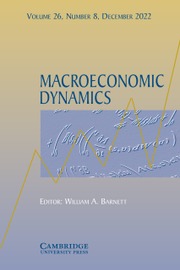Article contents
Transitional Dynamics of Optimal Capital Taxation
Published online by Cambridge University Press: 01 December 1998
Abstract
A known result holds that capital taxes should be high in the short run and low or zero in the long-run steady state. This paper studies thedynamics of optimal capital taxation during the transition, when a highrate is no longer optimal but the economy is still in flux. The mainresult is that capital should be taxed whenever the sum of theelasticities of marginal utility with respect to consumption and laborsupply are rising and subsidized whenever this sum is falling. If theutility function displays increasing relative risk aversion, thisparadoxically implies that capital should be taxed when the capital stockis below the modified golden-rule level and subsidized whenever it exceedsthis level. Thus, savings incentives sometimes can be more desirable whenthe capital stock is large than when it is small.
Information
- Type
- Research Article
- Information
- Copyright
- © 1998 Cambridge University Press
- 3
- Cited by

